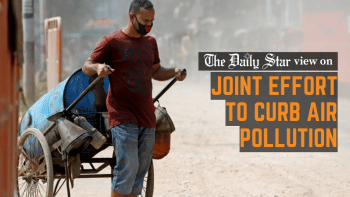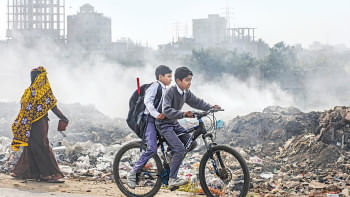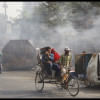Will the new air pollution control rules save us?

After a long wait, the Ministry of Environment, Forest and Climate Change recently published the Air Pollution (Control) Rules (APCR), 2022 as a gazette notification, aiming to curb the harsh air pollution in Bangladesh. Although the document was first drafted as an act in 2019, it was issued as a set of rules under the Environment Conservation Act (ECA), 1995, keeping most of the points of the original document.
Now, a question has been raised as to whether the rules would be stringent enough to control air pollution, and whether the relevant authorities would be liable enough. It is also imperative to review the strength of the authorities concerned and the coordination mechanism among the relevant organisations. It should be noted that the earlier ambient air quality standards and vehicular emission standards, which were set by another set of rules under the ECA, could not be met in more than one and half decade. In these circumstances, a possible way forward needs to be devised and implemented systematically to meet the target set in the APCR. But before discussing that, let us first look at our air quality scenario.
Air pollution in Bangladesh has been worsening with the increasing level of fine particulate matter (particulate matter with diameter less than 2.5 microns), which is greatly responsible for many serious non-communicable respiratory diseases such as bronchitis, chronic obstructive pulmonary disease (COPD), lung cancer, etc, and is associated with cardiovascular problems, diabetes, etc. Almost the entire population of the country now lives in polluted air heavy with the level of fine particulate matter greater than deemed safe by the World Health Organization (WHO). Data from the Department of Environment (DoE) shows that the middle part of the country (Dhaka, Gazipur, Narayanganj) is the most polluted region, while the northeastern part (Sylhet division) is comparatively less polluted.
The level of fine particulate matter in Dhaka is more than double the first interim target set by WHO, and about 15 times greater than the final target it suggests. The city is one of the top 20 most (air) polluted cities in the world, and is just behind Delhi in the list of the top most polluted capital cities. The cost of this pollution is enormous: more than 200,000 people died prematurely in Bangladesh in 2019 due to air pollution, according to the State of Global Air report published by the US-based Health Effect Institute. The World Bank (WB) estimated Bangladesh's economic loss due to air pollution to be equivalent to about four percent of the GDP in 2019, which is concerning.
There are different scientific data regarding the contributing sources to Dhaka's air pollution. While some studies point to brick kiln emissions as the main sources, some point to dust sources, and others to vehicular emissions. The latest report published by the World Bank (2022) attributed 85 percent of the fine particulate matter in Dhaka's air to long-range sources. Among the sources, industries are responsible for 35 percent of the pollution in Dhaka (including 14 percent from brick kilns), and household sources (cooking, generator, etc) for 28 percent of the pollution. Although it is hard to believe that only 10 percent of the anthropogenic pollution is generated within the city (according to the World Bank), we must agree that a substantial amount of fine particulate matter during the dry season in Dhaka comes from long-range sources. Thus, The APCR will face great challenges in devising and implementing cost-effective solutions for sustainable improvement in air quality.
According to the rules, the DoE will monitor the countrywide air quality continuously and tag a region as "degraded airshed" if it does not satisfy the national standards. The DoE will prepare air quality improvement plans (AQIP) for each of the degraded airsheds; a national air quality management strategy (NAQMS) will also be prepared. These tasks are highly important, but will require laborious, systematic and coordinated approaches with skilled manpower. While in-depth scientific work (monitoring, modelling and analyses) to identify the real causes of air pollution are required, economic analyses are needed to find cost-effective control measures. Beijing, known for its air pollution, has been able to maintain steady GDP growth for the last three decades even within its expanding investment and control over the air quality improvement programmes, which has improved its air quality by about 50 percent. This achievement is the result of a cost-effective strategy with determined implementation.
The AQIP and NAQMS will, thus, be prepared based on scientific and economic analyses, social awareness, coordination, logistics, etc. For example, to enforce the standard of 35 microgram per cubic metre (set by the APCR for fine particulate matter) in Dhaka, the maximum tolerable amount of fine particulate matter within the city's airshed needs to be calculated first. To do so, we need to figure out the types and number of sources (including those outside the city) and their contributions to the total amount of fine particulate matter. The cost-benefit analysis of the available control options for the sources will help us plan the enforcement mechanism.
For policy considerations, we may initially enforce firmly on the less important but big contributing sources (like dust), while we may focus on limiting emissions from the important sources (like exporting industries) by improving management and retrofits of the outdated instruments. We may also be stringent on the sources that emit very harmful pollutants like lead, chromium, persistent organic pollutants, etc. In some cases, based on analyses of air quality data, topography, socio-economic features, etc, we may need to set time variation for the operation of particular sources, and sometimes may need to relocate sources.
As per the APCR, a high-level national committee with the cabinet secretary as president, and with 26 members from the relevant ministries, departments, authorities, city corporations, and educational institutions may be formed. This committee will oversee the implementation of AQIP and NAQMS, function as the centre of coordination among relevant organisations, and advise the government on air quality improvement issues. The APCR has also provided guidance and directives to the industries, local government institutions, and other government and non-government organisations on how to limit emissions from their facilities or constructions. However, if any party does not comply with the emission guidelines or the directives outlined in the APCR, they could be punished with up to two years of imprisonment.
The APCR could be an effective tool to control the continued harsh air pollution in Bangladesh. But its sustainable success will depend on the factual preparation of AQIP and NAQMS and their persistent implementation. The DoE and local government institutes have to play major roles here. The DoE may also arrange to broadcast real-time air quality status and the forecasts of air quality for other responsible authorities as well as the general public. This may prove to be a challenging job that requires extensive resources, it may lessen the harsh impacts on public health and agriculture through informed preparations. The DoE is now expected to make the necessary arrangements immediately to initiate the tasks outlined in the APCR, and enforce it accordingly to ensure a healthy life and environment.
Md Masud Rana is an air quality consultant who works with the Department of Environment of Bangladesh, European Union, World Bank and other relevant organisations on air quality issues.

 For all latest news, follow The Daily Star's Google News channel.
For all latest news, follow The Daily Star's Google News channel. 











Comments